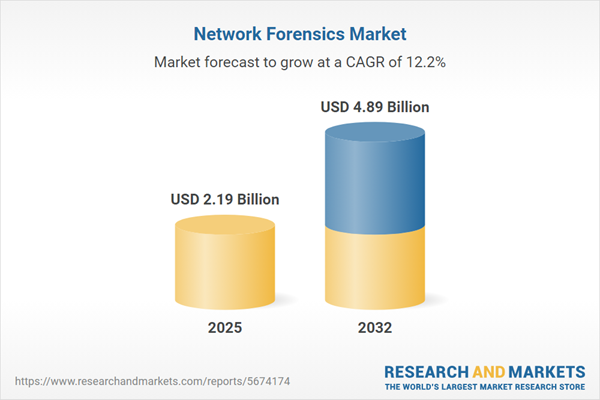Speak directly to the analyst to clarify any post sales queries you may have.
Network forensics serves as a cornerstone for enterprise cybersecurity, delivering comprehensive threat analysis and helping organizations safeguard their digital assets as they navigate increasingly complex IT environments. Essential for compliance and operational risk management, these technologies support both digital transformation and evolving governance requirements.
Market Snapshot: Network Forensics Market and Growth Outlook
The global network forensics market is forecast to expand from USD 1.94 billion in 2024 to USD 2.19 billion in 2025, with expectations of reaching USD 4.89 billion by 2032. This reflects a steady compound annual growth rate (CAGR) of 12.21%. Increasing threat sophistication and the proliferation of connected devices are driving demand for advanced forensic solutions across sector lines. Organizations are prioritizing unified analytics, adaptive architectures, and near real-time intelligence to meet both operational and compliance objectives, accelerating the adoption of robust network forensics across diverse business segments.
Scope & Segmentation of the Network Forensics Market
- Components: Managed services, consultancy, hardware, and software solutions enable seamless integration, deployment, data capture, forensic analysis, and ongoing monitoring, aligning with enterprise needs across industries.
- Deployment Mode: Cloud-based solutions offer scalable, flexible collaboration for distributed teams, while on-premise models ensure control, data sovereignty, and compliance with stringent local regulations.
- Organization Size: Centralized forensic frameworks cater to large enterprises with extensive infrastructure, while small and medium businesses benefit from scalable, cost-effective solutions to boost efficiency and streamline security practices.
- Application: Network forensics supports compliance auditing, threat detection, and incident response, appealing to digital-first organizations as well as highly regulated industries with complex security needs.
- End User: Sectors including banking, financial services, government, defense, energy, utilities, healthcare, retail, telecommunications, and IT leverage tailored forensic tools to address unique compliance and risk management priorities.
- Regions: Adoption rates are highest in North and Latin America, supported by evolving regulations and solid digital infrastructure. Europe, the Middle East, Africa, and Asia-Pacific regions see expanded implementation through regulatory evolution and innovation in forensic technology.
- Companies: Major providers such as Cisco Systems, IBM, Splunk, Palo Alto Networks, FireEye, LogRhythm, RSA Security, NETSCOUT Systems, Vectra AI, and Darktrace deliver intelligence solutions and integrated platforms for complex deployments and compliance mandates.
Key Takeaways for Senior Decision-Makers
- Network forensics provides transparent oversight across cloud-based and hybrid IT environments, helping leaders reinforce governance and risk management practices.
- Solution providers prioritize interoperability with regulatory changes, empowering organizations to adapt deployment models while sustaining operational continuity.
- Growth in network connectivity and encrypted data flows highlights the necessity for adaptable forensic technologies to identify and address emerging threats promptly.
- Close collaboration among technology partners and internal IT enhances detection capabilities, refines incident response, and enables greater process automation for agile operations.
- Access to advanced deployment expertise and ongoing training for security teams drives a stronger compliance posture and resilience across enterprise operations.
Tariff Impact: US 2025 Policy Shifts
Changes in United States information and communication technology tariffs are shaping sourcing and investment decisions in network forensics. Businesses are accelerating the shift to software-centric, cloud-based solutions for flexibility and cost management, broadening supplier bases, and diversifying technology portfolios to preserve cybersecurity standards amid evolving trade dynamics.
Methodology & Data Sources
This report synthesizes secondary research, structured interviews with subject matter experts, proprietary industry surveys, and external validation. The value-driven approach ensures senior technology leaders and investment teams receive actionable, credible market insights tailored to strategic decision-making.
Why This Report Matters
- Aligns cybersecurity investments with evolving risk mitigation and compliance objectives for executive stakeholders navigating a changing market landscape.
- Provides actionable recommendations for integrating forensic tools, whether advancing large-scale digital transformation or optimizing existing security operations.
- Delivers focused analysis for managing compliance challenges and achieving operational goals amid regulatory shifts.
Conclusion
Network forensics remains integral to enterprise resilience. Adopting advanced forensic solutions positions organizations to manage risk effectively and ensure continuous operations as digital and regulatory complexities accelerate.
Additional Product Information:
- Purchase of this report includes 1 year online access with quarterly updates.
- This report can be updated on request. Please contact our Customer Experience team using the Ask a Question widget on our website.
Table of Contents
3. Executive Summary
4. Market Overview
7. Cumulative Impact of Artificial Intelligence 2025
List of Figures
Companies Mentioned
The companies profiled in this Network Forensics market report include:- Cisco Systems, Inc.
- International Business Machines Corporation
- Splunk Inc.
- Palo Alto Networks, Inc.
- FireEye, Inc.
- LogRhythm, LLC
- RSA Security LLC
- NETSCOUT Systems, Inc.
- Vectra AI, Inc.
- Darktrace Limited
Table Information
| Report Attribute | Details |
|---|---|
| No. of Pages | 185 |
| Published | November 2025 |
| Forecast Period | 2025 - 2032 |
| Estimated Market Value ( USD | $ 2.19 Billion |
| Forecasted Market Value ( USD | $ 4.89 Billion |
| Compound Annual Growth Rate | 12.2% |
| Regions Covered | Global |
| No. of Companies Mentioned | 11 |









